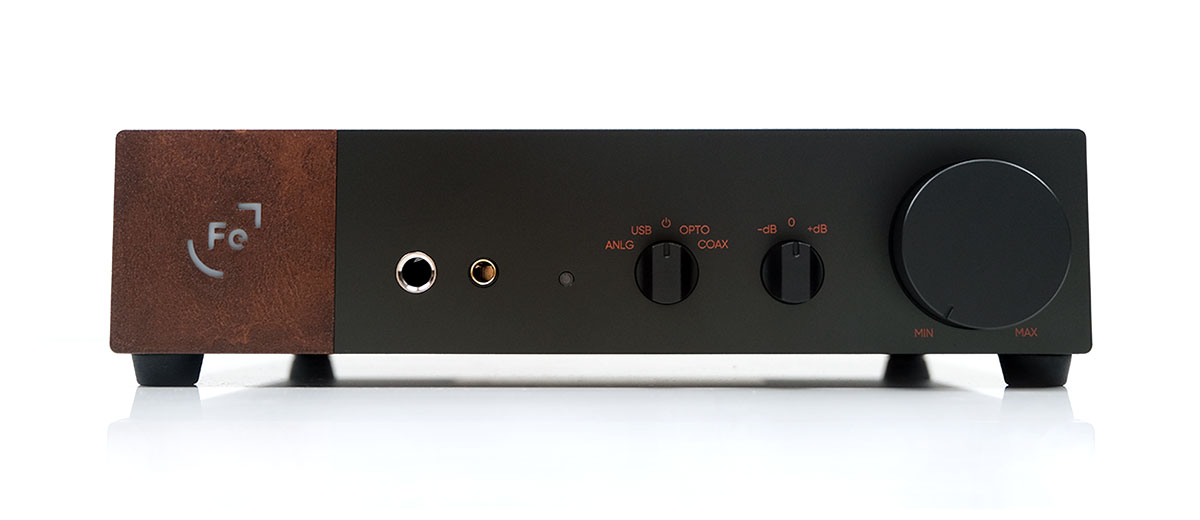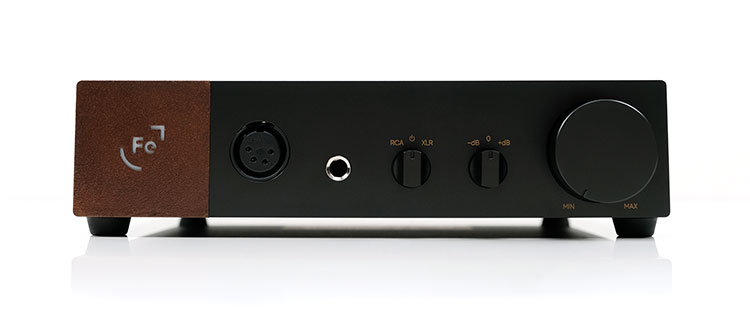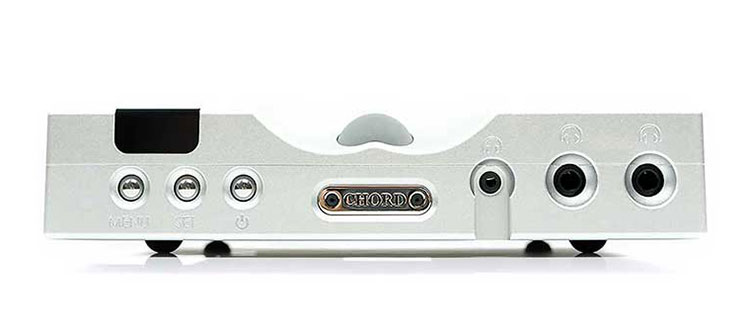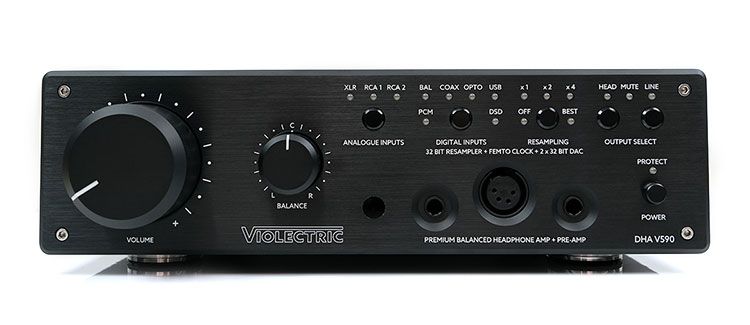Select Comparisons
All comparison work was completed using an Audeze LCD-5 and a T+A Solitaire P headphones. In the case of the OOR pure amp, the ERCO DAC’s balanced output was used as a source.
Ferrum OOR
Since the ERCO can operate as a pure amplifier, the OOR seems an obvious starting point for those wondering if the ERCO can compete, thus saving money having to buy a 3rd party DAC.
$1995
Technical
The OOR is a pure analog amplifier meaning there is no DAC inside. Having said that, there is some overlap with the ERCO on technical features when comparing their amps and PSU. For example, both offer a DC coupler connection for a linkup to the HYPSOS where you can fiddle with SST values for both for fine-tuning.
Ferrum has also split the power rails between the digital and analog inside the ERCO to keep the noise floor and the potential for unwanted distortion as low as possible. They also share the same evenly controlled Alps pot for PO and variable volume control via pre-amp duties.
Both offer single-ended and balanced inputs and outputs with a balanced topology. However, the OOR is a modified Class AB design and is completely discrete whereas the ERCO uses a proprietary integrated circuit design for its amplification. The two units also feature Ferrum’s bypass technology to act as a standalone amplifier power stage.
Where the OOR pushes ahead is in the output power ratings as you might expect. The ERCO is quite healthy in my estimation at 6.1W into 50Ω balanced and 1.7W into the same load going single-ended.
Even so, the OOR is stronger at a maximum output rating of 8W into 60Ω balanced and 2W into the same load when using the single-ended output.
Both amplifiers will drive plenty of demanding headphones with some gusto but if you want that extra mile in terms of dynamics with the likes of the Susvara, the OOR is the better fit.
Design
The design of these two units is virtually identical right down to the weight and dimensions. The branding, aesthetics, and materials used such as Corten steel for the paneling all match, as does the matt black front panel with the terracotta-themed logo portion on the far left.
The major differences are in the controls and I/O to the front and the rear and this is where I think it gets interesting because it gives me the impression that Ferrum did not want a huge overlap between the OOR and the ERCO.
Granted, we have a DAC inside the ERCO which brings a bit more complexity to what is on offer. Aside from purely analog inputs and outputs, we do have a new digital array including coaxial, optical, and USB as well as a source sector switch to the front.
Being a pure amp, the OOR will only share the 3-stage gain and Alps volume controls and here the OOR’s dB rating is slightly higher than the ERCO’s equivalent gain levels. The OOR also controls whether the signal out is balanced or SE whereas the ERCO does it automatically via internal. microcontrollers
To the rear, both have balanced outputs but only SE for an analog input on the ERCO. To the front, both units have balanced and SE PO, and here I bring you back to the product distinction I spoke about earlier.
There is no XLR headphone output on the ERCO, and instead, we have 4.4mm for balanced connections. A more modern balanced port type for sure, but one that also does not eat into the appeal of one of the OOR’s key features.
Performance
With both using their switching power supplies you hear a timbral coloration that is broadly in the same ballpark. Perhaps just a shade softer and smoother from the ERCO on the low-end and a bit more dynamic and defined from the OOR but the gap isn’t huge.
I would describe both as being largely linear-sounding amps that keep a fairly reference-like grip on their presentations.
Where the OOR differs is in the dynamic range performance, particularly on the bass response. It does reach a little deeper, sounds more impactful, and is a little tighter compared to the ERCO amplifier.
ERCO has a shade more bloom through the upper bass which I dare say creates that tiny sheen of additional warmth and sweetness through the lower mids. The OOR is more neutral in that regard but also more vivid and accurate in the delivery of its midrange with the ERCO DAC as its source.
I suspect some of that accuracy comes from the way the two amps differ slightly in treble reproduction. Again, on a macro level, there is little to separate them with a similar linear smooth but extended treble performance using both headphones.
However, with the Solitaire P, you can hear a little more grain and sibilant presence in higher pitching vocals whereas the OOR keeps a lid on vocal sibilance with an almost perfect harmonic balance from the same headphone.
Vocal runs also seem just that bit tighter on the OOR whereas with ERCO individual words tend to ‘glide’ a little more into each other.
Chord Electronics Hugo TT2
A slightly more expensive solution but in many ways, these two share a lot of similar features. You can check out our full review of the TT2 from last year here.
£3995
Modular
Both the Hugo TT2 and the ERCO are all-in-one devices with a degree of modularity to link with additional components from the company’s lineup. In the case of the TT2, it’s the Hugo M Scaler and the TToby power amp. For the ERCO it’s the DC coupler port for linking up with the HYPSOS standalone PSU.
As an interesting side note, the use of the HYPSOS is not mutually exclusive for Ferrum products. There is a setting also for the TT2 in the HYPSOS menu and you can link them both despite the TT2 not having a coupler input with the HYSOS supplied 5.5/2.5mm and 5.5/2.1mm DC jacks.
The feature set for the TT2 includes an integrated DAC/AMP, pre-amp, and a secondary DAC for alternative 3rd party sources with digital outputs, (such as but not limited to the M Scaler).
In some ways, the ERCO is a little bit more open-ended as a system though with the ability to receive an analog input (SE only) whereas the TT22 is a closed system with no direct access to the built-in amp.
Technical
The DAC itself inside the TT2 is not delta-sigma which the ERCO uses with its ES9028PRO chipset implementation. Instead, it is a Chord FPGA-based solution relying on a Xilinx Artix 7 FPGA processor and FIR tap-based filtering for the conversion.
Decoding output on the TT2 is higher at DSD512 and PCM 768kHz with additional upsampling capability indirectly via the M Scaler.
The ERCO is a little lower at DSD256 and PCM up to 32BIT/384kHz. One thing missing, though Chord will be perfectly fine with it, is native MQA unfolding which is up to 8X on the ERCO. Chord simply does not believe in MQA.
For amplification, the TT2 uses a Class amplification topology but does not offer balanced headphone output, just single-ended only. It does, however, offer balanced and SE pre-amp output on the rear.
The SE headphone power rating for both is in the same ballpark with the TT2 rated at up to 2.7W into 32Ω compared to 1.7W into a higher 50Ω load rating for the ERCO. The ERCO will go much higher though with its balanced output at 6.1W into a 50Ω load.
Design
Very different design philosophies here though it is hard to argue against the TT2 having slightly superior engineering with its finely machined curving and an array of indicators such as the small LED screen, front panel button control, and the ever-present orb light system.
I would say though that both brands have a finely tuned understanding of design language and certainly stacking the TT2 feels right at home with a TToby underneath and an M Sampler above. They all match in terms of dimensions similarly to how the ERCO slides right in with the OOR and/or the HYPSOS.
There is an argument though for the ERCO being much simpler to understand and operate.
Chord products are never pick-up-and-play units with a steeper learning curve, not least with the multiple orbs status indicator light codes and the linear menu system inside the LED display. The TT2 LED display can also get hidden somewhat if you stack anything on top of it.
For I/O there is some commonality with both offering pre-amp SE and balanced output, however, on the PO side, the TT2 is a pure SE operator whereas ERCO offers both balanced and SE PO. You do get up to 3 SE outputs with the TT2 with a single 3.5mm and dual 6.35mm outputs.
For digital inputs, both offer optical and USB but one of the edges of the TT2 is its dual BNC functionality which is perfect for linking to the M Scaler or using one for coaxial input.
The TT2 also has additional DX BNC outputs but I have never used them personally. One other side note is that there are two optical inputs not one for the TT2, the ERCO only has one.
Performance
With both in high gain mode using the Solitaire P there are several distinguishable differences between these two all-in-one units.
The Hugo TT2 is probably the more natural sounding and the least digital in its timbre. Attacks break very smoothly with a very even harmonic balance to produce a very high-fidelity sound with a ton of resolution, especially through the mids.
The ERCO has a cleaner coloration, a bit drier in its timbre but not a dry-sounding amp in its own right, only comparatively so. Treble tuning is a touch further forward in comparison, so notes have an edgier attack and a little harder in tone.
However, one could easily argue it is a livelier tone with more bite in its midrange percussion depending on your preferences.
One area that I think the ERCO competes well with the Hugo 2 is bass punch and general PRaT levels. The TT2 tends to do its magic in terms of transparency and clarity through the mids and highs but it comes at a price with a very neutral bass in terms of quantity.
The ERCO sounds punchier on the lows, perhaps extending a little deeper also so whilst it lacks the TT2’s hyper-realism and panache for micro-detail it delivers a bit more ‘drive’ and rhythm to audio tracks.
The TT2 envelops you will low-end detail and extends very deeply with gear that can dig deep in their own right, but its slam is polite in comparison.
Violectric V590
Again, a slightly more expensive solution but one which overlaps considerably on a lot of the key features of the ERCO. You can find our full review of the V590 from 2020 here.
$3499.95
Technical
Both units are integrated DAC/Amps with pre-amp capability. However, the V590 carries a little bit more with its user-controllable 32BIT upsampling feature and it does work having extensively used it over the last 2 years.
That being said, I find the ERCO DAC implementation to be a more elegant solution with a single ES9028PRO chipset compared to the aged dual AKM AK4490s inside the V590.
Decoding on both is close, however. The V590’s USB Combo384 Module will give you up to 32BIT/384kHz PCM and DSD256 which is the same as the ERCO. The ERCO will also throw in 8X MQA decoding to compensate for V590’s upsampler module.
That elegance though comes with fine detail. The THD+N of the V590 tops out at < -102 dB / < 0.0008 % whereas the ERCO is rated at a maximum of < 0.00018% / -115 dB. Both are 1W A-weighted readings as far as I can tell. Of the two, I would say the ERCO has the lower noise floor after conversion and amplification.
For power, it is close. The Class AB amp of the V590 has a slight edge at a maximum of 6.4W into 50Ω balanced compared to 6.1W into the same load from the IC integrated amp of the ERCO.
Both amps also have a range of gain stages with the V590 being a little more comprehensive though much the fiddlier of the two with its rear dip switch system.
Still, if you want to you can have gain levels ranging from -18dB to +18dB and from -6dB to +6dB from 4 fixed gain settings. The ERCO has 3 at a maximum of -5.8 dB, +6 dB, or +17.8 dB but they are simpler to operate and on the front panel for easier access.
Design
The V590 looks like a beast compared to the more diminutive and much lighter ERCO. Most likely the huge weight difference is down to the two 25W toroidal transformers inside the V590 as well as an all-aluminum casing including an 8mm thick front panel. No doubt it is the more robust of the two desktop solutions.
The V590 is in no way designed to be part of a stack. If you are pre-amping say a V281 or using one of their DACs you can, of course, stick it on top but the shape and design of the V590 are not as harmonious as the ERCO ecosystem.
The design language of the V590 is very much ‘Violectric’ though with more of a solid industrial business look. The ERCO is a modern minimalist, far less busy looking both front and back and I would say more for the high-end no-fuss audiophile who wants to plug and play.
The V590 sucks you in a bit more in terms of tweaks with the vast array of features front side including that upsampler module.
It also has the classic 4-pin XLR/6.35mm SE and balanced PO compared to the 4.4mm/6.35mm setup of the ERCO which again taps into what Ferrum sees as being more appealing to a modern audiophile in 2022.
What’s missing? Well, analog channel balancing is a nice feature from the V590 that the ERCO does not have as well as the ability to receive a balanced line-in as opposed to single-ended only.
On the digital side, the V590 also uses a classic USB-B input as opposed to USB-C and also has an AES/EBU connection option. The ERCO has more modular capability with its trigger port and DC coupler for the HYPSOS.
Performance
In terms of dynamic range, you will be hard-pressed to find a difference between these two units. Both the V590 and the ERCO’s amplification stages are well-designed with excellent gain stages.
For this comparison, we have both units on full gain to cope with the inefficient Solitaire P and both had no issues driving it.
For coloration, the ERCO is the slightly cleaner sounding of the two amps but how much cleaner depends on which upsampling mode you choose on the V590.
Keep it off and the treble has more presence coloring the Solitaire P’s upper mids and fleshing out that 7k peak with a bit more focus. It is not as attractive a treble tone as the ERCO top-end which sounds purer to me but then I have always felt that way about the AK4490 chipset tuning.
Turn on the upsampling to ‘Best” and you get a smoother quality to the V590, perhaps more euphonic in coloration through the more forward mids compared to the ERCO.
This in turn gives the ERCO its comparatively reference-like trait and where you will find yourself thinking, well, the ERCO is the more reference setup and the V590 is the more ‘musical’ of the two.
One area the V590 does very well is the bass performance. The ERCO is punchy, probably tighter, and more articulate also but does not reach quite as deep or sound as fulsome as the V590 with both the LCD-5 and the Solitaire P.
It is a positive trait for me of the AK4490 in how much gusto this chip has for bass physicality and Violectric has been known to produce some excellent bass performers in their amp range such as the V281.
Our Verdict
Yet another very likable, professionally designed desktop unit from Ferrum. If the OOR/HYPSOS stack and a search for a quality DAC to get the best out of those two was out of your reach then the ERCO on its own will provide a very enjoyable and fiscally less stressful complete desktop experience that comes close.
The ERCO DAC is neutral to natural, accurate, and articulate. Its amplifier has bags of power to drive just about any headphone you want to throw at it. It is also incredibly simple to operate right out of the box.
Some might moan about the lack of XLR balanced PO or a balanced input from a source to the rear. A couple of compromises there to be sure but as mentioned a few times, I can see why 4.4mm was chosen with XLR remaining the preserve of the dedicated OOR amplifier.
The bonus point though has got to be that the ERCO is HYPSOS compatible. If you happen to have one that is. If you do, it does give the stock performance a very satisfying lift.
Ferrum ERCO Specifications
- Headphone output gain: balanced -5.8 dB, +6 dB, +17.8 dB; single-ended -11.8 dB, 0 dB, +11.8 dB
- Operation: fully balanced, proprietary IC power amp
- Power inputs: 5.5/2.5 mm DC connector center positive; proprietary FPL 4-pin DC connector (FPL)
- Analog inputs: RCA (Consumer level; Pro option with future software update)
- Digital inputs: USB-C (MQA, up to PCM 32-bit/384 kHz, DSD256, DoP128)
- S/PDIF coaxial (MQA, up to PCM 24-bit/192 kHz, DoP64)
- S/PDIF optical (MQA, up to PCM 24-bit/96 kHz guaranteed, should work up to PCM 24-bit/192 kHz and DoP64 – depends on user’s optical cable and transmitter)
- DAC chip: ESS Sabre ES9028PRO
- PCM sample rates: 44.1 / 48 / 88.2 / 96 / 176.4 / 192 / 352.8 / 384 kHz
- DSD sample rates: 2.8224 / 3.072 / 5.6448 / 6.144 / 11.2896 / 12.288 MHz
- MQA: decoder and renderer (USB, OPTO, and COAX inputs)
- DAC resolution: PCM up to 384k@32bit; DSD up to 256 (11.2 MHz / 12.2 MHz)
- Headphone jack outputs: balanced 4.4 mm (TRRRS); unbalanced 6.35 mm (TRS)
- Line outputs: balanced XLR; unbalanced RCA (both Consumer level; Pro with future software update)
- Volume control: analog with bypass option (bypass for line outputs only)
- Frequency response: 10 Hz – 30 kHz (+/- 0.05 dB) 10 Hz – >200 kHz (+/- 1 dB)
- Output power unbalanced: 300 mW into 300 Ω; 1,7 W into 50 Ω
- Output power balanced: 1.2 W into 300 Ω; 6.1 W into 50 Ω
- THD on balanced output: < 0.00018% / -115 dB, 1 mW into 16 Ω; < 0.00018% / -115 dB, 100 mW into 16 Ω
- THD on unbalanced output: < 0.00032% / -110 dB, 1 mW into 16 Ω; < 0.00057% / -105 dB, 100 mW into 16 Ω
- Dynamic range analog: 130 dB (A-weighted)
- Dynamic range digital: 120 dB (A-weighted)
- Input impedance: 47 kΩ
- Output impedance unbalanced: 22 Ω on pre-amp
- Output impedance balanced: 44 Ω on pre-amp
- Output impedance Headphones: < 0.3 Ω
- Power consumption: idle <15 W
- Power adapter: 100-240V AC to 22-30V DC
- Dimensions (W x D x H): 21.7 cm x 20.6 cm x 5 cm / 8.6” x 8.1” x 2.0”
- Weight: 1.8 kg / 3.97 LBS






